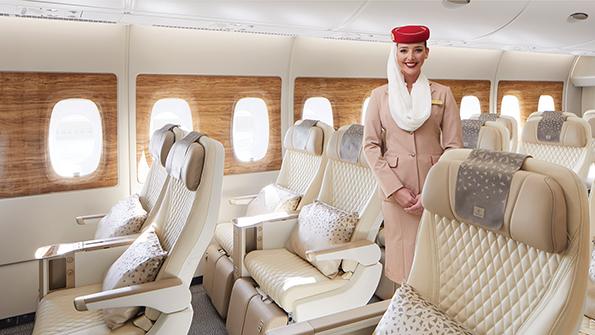
Emirates is upgrading its widebodies’ premium-economy (pictured), business-class and first-class sections.
Aircraft interior modification projects have been on the rise in past year as airlines recover from the pandemic downturn and work to enhance the passenger experience.
In early August 2022, Emirates launched a $2 billion cabin upgrade project for 67 Airbus A380s and 53 Boeing 777s. The project, undertaken by the airline’s Dubai-based Emirates Engineering division, is planned to run until April 2025 on a schedule of four aircraft per month undergoing retrofits. All of the A380s should be back in service by May 2024; the carrier aims to begin work on the Boeing 777-300ERs after that.
Technicians are slated to install 4,000 new premium-economy seats, more than 5,000 upgraded business-class seats and approximately 728 refurbished first-class suites. The airline also is replacing cabin carpets and stairs and refreshing cabin interior panels with new colors and designs.
Emirates looks for sustainable processes and materials for such projects and insists on both upcycling and recycling. Ahmed Safa, divisional senior vice president of engineering at Emirates, says that for the widebody project, the carrier has worked out a process with its manufacturing partners to reuse existing parts and use materials that have a high score on the environmental index. The airline is choosing lighter-weight materials as well, to reduce carbon dioxide emissions.
To ensure the project could be executed safely and on time, Safa says the team conducted multiple trials, including time-motion studies on a spare A380 parked due to the pandemic. Additionally, the team conducted a thermal-motion study so it could understand the risk of weather conditions. Following the trials and studies, Emirates was able to start the project with risk factors minimized.
Furthermore, to optimize turnaround time and cost effectiveness, the company transfered skill sets and knowledge bases to Dubai and built temporary workshops to expedite the execution of the project, Safa explains.
Emirates finished the cabin upgrade on the first of the 120 aircraft—an A380—in January. However, due to supply chain issues, it took much longer than the company expected.
“The biggest issue we have faced and continue to face is the material supply chain and the quality of the finished products,” Safa says. “We are working with our partners to resolve the issue. They have stepped up to the requirements and injected a lot of additional procedural improvements, processes and all necessary inputs that will bring back the turnaround time to the initial 20 days.”
The other main challenge faced by technicians during the retrofit of the first A380 was the amount of work that had to be completed in a short time. The process of refurbishing the aircraft and returning it to service in 20 days was not a small feat for Emirates. Safa notes that while the airline had laminated panels, walls, dividers, features and other cabin monuments without removing them on previous projects, it had not done so to this degree of intensity.
“The technicians completed the task without compromising on quality and managed to exceed expectations by ensuring that none of the panels exhibited any bubbling during the first flight following the refurbishment,” he says.
Emirates has received positive customer feedback regarding the first retrofit, and the second aircraft undergoing renovation was expected to be ready by the end of January.
“[The refurbishment project] is going to cement and enhance our reputation as a leader,” Safa says. “Certainly, it is going to set a new standard for what the average public would expect from the airline, and it is probably going to prompt a lot of airlines to do more with their aircraft.”
The airline also plans to invest in other projects to enhance the passenger experience. “This is only Phase One,” Safa says. “In the next phase, we will probably be looking at the inflight entertainment system, brand-new seats in all classes and all the other features in the cabin as well.”





